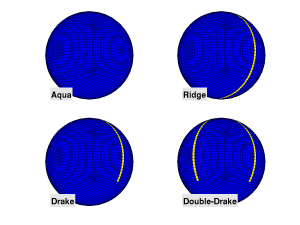The dynamics of Aqua-planets
Aqua-planets are Earth-like planets with an atmosphere and ocean like our own, but with highly schematized land distributions. They provide a context for the study of:
- the elemental role of the ocean in climate
- questions raised by the paleo-record
- planetary dynamics.
In our aqua-planet studies the geometrical constraints on ocean circulation and extent of land are reduced to a minimal description: a sequence of ‘stick models’. The ‘sticks’ are narrow vertical barriers in an otherwise flat-bottomed ocean, which extend from the bottom of the ocean to the top: there is no orographic forcing of the atmosphere.
The sequence from Aqua to Ridge to Drake to Double Drake can be regarded as a ‘cartoon’ that increases the level of geometrical complexity: from the pure Aquaplanet (where there are no topographic constraints on ocean circulation) to the Double Drake (in which two barriers arcing down from the north pole delineate a small basin and a large basin, with an unblocked circumpolar region over the south pole). The Double Drake captures the two essential aspects of basin geometry of our present world: inter-hemispheric asymmetries (zonally blocked flow in the north, unblocked in the south) and zonal asymmetries (a small basin and a large basin).
Study of this system has enabled to probe:
- the partitioning of heat transport between the atmosphere and ocean and constraints on the total (A+O) heat transport [95], [103], [104] and [109]
- multiple equibria of the coupled climate – amazingly the aquaplanet system (and perhaps the real climate too) exhibits more than one stable state for the same external forcing – [113], [124], [139]
- zonal asymmetries in climate such as localization of the ocean’s MOC to the small (Alantic) basin – [119], [141]
- inter-hemispheric asymmetries in climate such as sinking around the north pole and upwelling around the south pole [109] and the displacement of the Inter-tropical Convergence Zone north of the equator [138], [150], [154]




